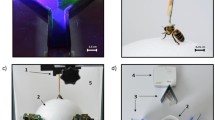Abstract
In visual operant conditioning ofDrosophila at the flight simulator, only motor output of flies—yaw torque—is recorded, which is involved in the conditioning process. The current study used a newly-designed data analysis method to study the torque distribution ofDrosophila. Modification of torque distribution represents the effects of operant conditioning on flies’ behavioral mode. Earlier works[10] showed that, when facing contradictory visual cues, flies could make choices based upon the relative weightiness of different cues, and it was demonstrated that mushroom bodies might play an important role in such choice behavior. The new “torque-position map” method was used to explore the CS-US associative learning and choice behavior inDrosophila from the aspect of its behavioral mode. Finally, this work also discussed various possible neural bases involved in visual associative learning, choice processing and modification processing of the behavioral mode in the visual operant conditioning ofDrosophila.
Similar content being viewed by others
References
Waddell, S., Quinn, W. G., What can we teachDrosophila? What can they teach us? Trends Genet., 2001, 17: 719–726.
Wolf, R., Heisenberg, M., Basic organization of operant behavior as revealed inDrosophila flight orientation, J. Comp. Physiol. A, 1991, 169: 699–705.
Guo, A. K., Liu, L., Xia, S. Z. et al., Conditioned visual flight orientation inDrosophila: Dependence on age, practice and diet, Learn Mem., 1996, 3: 49–59.
Xia, S. Z., Liu, L., Feng, C. H. et al., Memory consolidation inDrosophila operant visual learning, Learn Mem., 1997, 4: 205–218.
Wolf, R., Wittig, T., Liu, L. et al.,Drosophila mushroom bodies are dispensable for visual, tactile, and motor learning, Learn Mem., 1998, 5: 166–178.
Wang, X., Liu, L., Xia, S. Z. et al., Relationship between visual learning/memory ability and brain camp level inDrosophila, Sci. in China, Ser. C, 1998, 41(5): 503–511.
Brembs, B., Heisenberg, M., The operant and the classical in conditioned orientation inDrosophila melanogaster, at the flight simulator, Learn Mem., 2000, 7: 104–115.
Heisenberg, M., Wolf, R., Brembs, B., Flexibility in a single behavioral variable ofDrosophila, Learn Mem., 2001, 8: 1–10.
Liu, L., Wolf, R., Ernst, R. et al., Context generalization inDrosophila visual learning requires mushroom bodies, Nature, 1999, 400: 753–756.
Tang, S. M., Guo, A. K., Choice behavior ofDrosophila facing contradictory visual cues, Science, 2001, 294: 1543–1547.
Wu, Z.H., Gong, Z. F., Feng, C. H. et al., An emergent mechanism of selective visual attention inDrosophila, Biol. Cybern., 2000, 82: 61–68.
de Belle, J. S., Heisenberg, M., Expression ofDrosophila mushroom body mutations in alternative genetic background: A case study of themushroom body miniature gene (mbm), Proc. Natl. Acad. Sci., 1996, 93: 9875–9880.
Heisenberg, M., Wolf, R., Vision inDrosophila: Genetics of Microbehavior, Berlin: Springer, 1984.
DeZazzo, J., Tully, T., Dissection of memory formation: From behavioral pharmacology to molecular genetics, Trends Neurosci., 1995, 18: 212–218.
Milner, B., Squire, L. R., Kandel, E. R., Cognitive neuroscience and the study of memory, Neuron, 1998, 20: 445–468.
Tully, T., Quinn, W. G., Classical conditioning and retention in normal and mutantDrosophila melanogaster, J. Comp. Physiol. A, 1985, 157: 263–277.
Dubnau, J., Grady, L., Kitamoto, T. et al., Disruption of neurotransmission inDrosophila mushroom body blocks retrieval but not acquisition of memory, Nature, 2001, 411: 476–480.
McGuire, S. E., Le, P. T., Davis, R. L., The role ofDrosophila mushroom body signaling in olfactory memory, Science, 2001, 293(5533): 1330–1333.
Martin, J. R., Ernst, R., Heisenberg, M., Mushroom bodies suppress locomotor activity inDrosophila melanogaster, Learn Mem., 1998, 5: 179–191.
Author information
Authors and Affiliations
Corresponding author
Rights and permissions
About this article
Cite this article
Wang, S., Tang, S., Li, Y. et al. Behavioral modification in choice process ofDrosophila . Sci. China Ser. C.-Life Sci. 46, 399–413 (2003). https://doi.org/10.1007/BF03192583
Received:
Issue Date:
DOI: https://doi.org/10.1007/BF03192583




